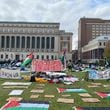In the dying sunlight the moment for the deadly hurricane was arriving.
Jeremy Redmon, one of our best reporters, sent me a few images of the water rising steadily toward my house on St. Simons Island. As some of you may remember, in the days as Hurricane Matthew lumbered angrily toward Georgia, I wrote in this space about my anxieties over my house and the wondrous 100 miles of Georgia coast in the storm’s path.
The main force of the storm was hours away. But the photos Jeremy sent that Friday evening triggered something in my gut: He and the other journalists covering the menacing hurricane were risking their lives. Jeremy had decided to ride the thing out in my now-darkened house with photographer Hyosub Shin. Newly minted AJC reporter Ben Brasch was on the mainland in Brunswick, filing pretty cool reports and Facebook live videos for our audiences.
In St. Mary’s near the Florida line, reporter Scott Trubey and photographer Curtis Compton were in position. On Tybee Island another veteran reporter, Dan Chapman, had also decided to experience the storm firsthand.
In St. Mary’s they were reporting flooding and heaving rain and wind, but nothing they couldn’t handle. But, it must be remembered, Scott and Curtis were on the mainland.
I became particularly worried about the guys on islands, where the risk was that they would be unable to return to the mainland.
In a story Jeremy had written earlier, Glynn County officials had issued a statement laced with apocalyptic wording: “Under the current forecast, total devastation of the barrier islands is possible. …”
Total devastation? The entire coast had been ordered evacuated. The cable weather industrial complex was eagerly describing the coming Armageddon.
The reporters were hearing the same things. “At one point, after a warning that Matthew could make landfall in the area of St. Marys, our destination, Curtis and I turned to each other and said in unison something that can’t be printed in a family newspaper,” Scott told me.
Yet, they drove on.
In the newsroom, we began checking our guts and offered everyone the option to pull back. No one took us up.
I swapped texts with Jeremy, who worried he and Hyosub would be unable to do their jobs if they left and risked being unable to report the aftermath. “We elected to stick it out, though my wife, JoAnn, wasn’t happy about it,” Jeremy told me Friday. “We took plenty of precautions. I didn’t sleep well on the night of the storm, partly because of the racket outside and partly because I kept getting beeping text messages on my phone — every hour on the hour — from you, JoAnn and Shannon (McCaffrey), who were kindly checking on our safety.”
Shannon was the editor keeping watch over our folks through the night.
But why remain in harm’s way?
“First, I believe it’s our job to get as close as possible to the action — at the tip of the spear so to speak — and let our readers know what’s going on through our stories and photos,” Jeremy continued. “If we didn’t, who would?”
Misty Williams, one of the editors closest to the coverage, connected the assignment to our overarching mission. “It’s our job as Georgia’s paper of record to be the voice of its citizens — to bear witness to the events that affect their lives sometimes in unalterable ways,” she told me. “During the hurricane, our reporters and photographers were on the ground side-by-side with those residents who chose to ride out the storm at home.”
And, to be honest, covering a big story is kind of what it’s all about. “It was the most important story in America,” Scott reminded me.
Jeremy, who was deployed to cover the war in Iraq three times, also was jazzed. “I admit such assignments are adrenaline-pumping,” he confessed. “Who else gets to do this kind of stuff and tell these sorts of stories?”
Up the coast, Dan also had decided to stay for the duration despite the likelihood that he would be stranded. The full force of the storm hit Tybee at around 2 a.m. Like the others, he worked without power — or plumbing — as the wind and waves surged. He chronicled his experience in an excellent first-person piece. Tybee was hit hard by the storm and Dan had found refuge in the second floor of a three-story house.
Shannon also kept tabs. “At 2:33 a.m. my editor Shannon asks if I’m OK. She says the storm appears to be on top of Tybee, though the center is likely 20 or so miles east into the Atlantic. I ask for wind speed, thinking the storm must be a Cat 3 again. Shannon says 105 mph sustained, still a Cat 2,” he wrote. “Durn, I text. I wanted a 3!”
At 7:19 a.m. on the Saturday morning after the hurricane struck, Dan’s phone buzzed with a text.
“Hey all OK?” It was Shannon. He was fine. Good, Shannon responded, get busy gathering news for the website.
A bit later, Dan ventured out to assess the damage. “Downed pine, palm and oak trees, or their branches, blocked roads. Other trees had sheared in half. A house on the main drag was bisected by a pine,” he wrote. “Two condo buildings in the middle of the island lost chunks of their roofs, exposing living and dining rooms. Sides and roofs were stripped bare. Power poles tumbled, their lines snaking dangerously along the ground.”
Flooding, downed trees and branches and considerable misery to come, but no large-scale disaster.
A bit late in the morning, I texted Jeremy and Scott. They were fine and already out working despite sleepless nights. The hurricane ignored the weather guys and scraped Georgia’s stunningly lucky coast without causing lasting harm.
It is hard to express my relief and pride. (Incidentally, our place came through with nothing that couldn’t be handled with a chainsaw, blower, wheelbarrow and good friends.)
The risk had rewarded us great journalism and the sense of being part of something that touched so many people.
Was it worth it? Shannon, a veteran who was acutely aware of the dangers, offered the simplest response: “We take such risks because it is the essential core of what we do.”
About the Author





